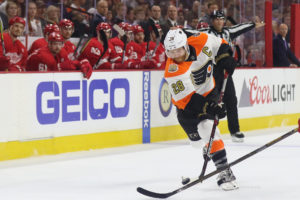The 2016-17 Philadelphia Flyers‘ season is one that will not only go down as a massive disappointment but one that could essentially be divided by the black and white difference in play from one-half of the season to the other.
There could be an argument made that the Flyers were in a ‘rebuilding mode’ for this season or even that they were never really supposed to be a good team, but that really shouldn’t fly considering this team has shown that they can do great things. It’s essentially a tale of two separate seasons all bundled into one. In one of those seasons, the Flyers are one of the top teams in the NHL. In the latter of the two seasons, the Flyers are a lifeless basement dweller.
In fact, in all of my years following and covering hockey, I’ve really never seen anything like it, so what went wrong?
The Better Half
I’ll refer to this as the 2016 season and yes, it was by far the better half.
We all vividly remember when the Flyers were riding high on their ten game winning streak. In fact, things were going so well during that time period that the Flyers were just two points away from the top spot in the division and the entire league. Things were looking good, real good.

What’s even more impressive was the way the Flyers were winning these games. Comebacks, shutouts, tight one-goal games and even the occasional dominating performance all were a part of how the team found a way to get into the win column
On top of that, the team was getting contributions from nearly everyone in the lineup. The Flyers had Wayne Simmonds (29 P), Claude Giroux (30 P), and Jake Voracek (33 P) in the top 10 in the league in points. Individual performances weren’t the only things that stuck out, the Flyers were playing well as a team. They ranked 3rd in the NHL in goals per game (3.19), 3rd in the league in shots per game (31.5), and had the second best powerplay in the league (23.5%).
Those are some staggering offensive numbers.
Now, that offense didn’t come without some problems. The Flyers were still allowing a lot of goals, in fact, they had given up the third-most goals in the NHL. However, that was largely overshadowed by the dominant offense and the defense had been improving since the start of the season.
The Flyers performance in their ‘2016 season’ had set themselves up to be a serious contender for the division, and it sure looked like they could be a serious contender in the playoffs. That was all about to come to a screeching halt.
The Forgetful Half
Now we move on to the 2017 season.
To say that this stretch of hockey has been abysmal would be an understatement. The only way to really detail how bad the Flyers have been since the start of 2017 is to talk about cold hard stats, so here they are some stats over that time span:
- The Flyers have averaged just 2.17 goals, 28th in the NHL over that timespan.
- The Flyers have gone 14-17-4, the fourth-worst record in the NHL over that timespan.
- The Flyers power play is 16.9%, 20th in the NHL over that timespan.
- No Flyer player is averaging a point-per-game over that timespan.
- Flyers players have posted 27 multipoint performances in 2017, they posted 48 in 2016.

Those stats speak for themselves, and when you compare them to where the team was in the first half, it really makes you shake your head and ponder what happened. The only area the Flyers had improved in is the number of goals they allowed per game. In 2017 that number was at 2.85 which was down from 2.97 in 2016.
A team really has to falter to go from nearly first in the conference to competing for last place in the conference. But where do the problems lie?
A frequent suggestion that I’ve come across is that the Flyers may need to explore the nuclear option. While that may seem enticing since the team just went through a freefall, it may not be the most viable or smart option.
With how bad the latter half of this season has turned out, it’s easy to forget that this group of players has proven that they can perform to an elite level, and they’ve most recently shown that in the first half of this season. Now, whether poor roster management and coaching are to blame for this is a story for a different day, however, it’s extremely hard to single out just one player in this whole mess when the team as a whole has seen a dramatic drop in production.
It’s very difficult to evaluate this season as a whole in Philadelphia because the 2016-17 season has really been split into the good and the bad.